Mealtime Partners, Inc.
Specializing in Assistive Dining and Drinking Equipment
November 2017 Independent Eating and Drinking Newsletter

|
November Topics:
|
||
|
Mealtime Partners Home Page Send a Comment or Suggestion |
|||
| Subscribe to Newsletters |
Mounting Drinking Systems onto Standard Powered Wheelchairs
This article will discuss some of the difficulties that people experience mounting drinking systems and electronics, like smart phones and Tablets, on their wheelchairs. If you review our previous newsletters you will find several articles that describe how to mount various drinking systems onto a variety of different types of wheelchairs. Yet many people experience difficulties with attaching anything to their powered wheelchairs.
The majority of people who use a powered wheelchair own or rent a wheelchair that is described as a "standard" powered wheelchair. A standard powered wheelchair is intended to be used by people who have difficulties walking more than short distances. They have a drive system that is controlled by a basic joystick with no functions other than ‘drive’. Other than seatback adjustment and foot plate height adjustment, the chair offers no positioning or pressure relief functions. Standard wheelchairs meet the needs of a large number of wheelchair users.
However, for individuals who have congenital disorders like cerebral palsy (CP), or who have progressive or degenerative diseases like amyotrophic lateral sclerosis (ALS), or who have injuries like spinal cord injuries (SCI), a standard wheelchair often cannot meet their functional needs. Because individuals who have severe disabling conditions need a powered wheelchair to augment their limited function, they need a more complex wheelchair.
The National Coalition for Assistive and Rehab Technology (NCART - www.ncart.us) provides the following definition of Complex Rehab Technology (CRT). The description includes the definition of complex wheelchairs as follows. “CRT products include medically necessary, individually configured devices that require evaluation, configuration, fitting, adjustment or programming. These products and services are designed to meet the specific and unique medical, physical, and functional needs of an individual with a primary diagnosis resulting from a congenital disorder, progressive or degenerative neuromuscular disease, or from certain types of injury or trauma. For this document, CRT refers to individually configured manual wheelchair systems, power wheelchair systems, seating and positioning systems, and other adaptive equipment such as standing devices and gait trainers.”
Complex powered wheelchairs, as a whole, have slide-track mounting systems, or have a frame and/or handles that facilitate clamping systems being attached to them. This enables Mealtime Partners drinking systems to be mounted to these types of wheelchairs.
Standard powered wheelchairs are not as easy to mount to. It appears to be presumed by the manufacturers that the user does not need any additional equipment attached to their power chair. An example of this philosophy is the absence, on “standard” wheelchairs, of a place to mount an oxygen tank for those who need to take oxygen with them when they move around in their wheelchair.
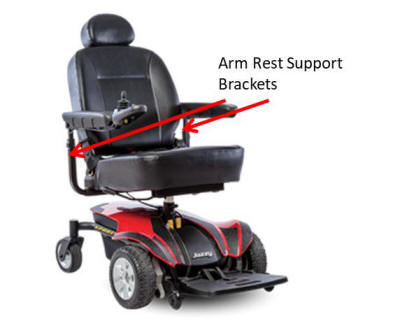
|
| Figure 1 – A Pride Jazzy "Standard" Powered Wheelchair |
As can be seen in the example of a standard powered wheelchair shown in Figure 1, above, standard powered wheelchairs are straightforward and functional without anything extra added to them. The question arises, “where do I put my drink”. If you Google wheelchair cup holders you will find a wide array of different cup holders. Almost all of them are attached to the wheelchair by a clamp that is rounded and must be mounted to a tube (i.e., round surface). Looking at the wheelchair photograph above, you will note that there are no tubular parts to which a cup holder can be attached. The armrest mounting brackets may look tubular but in fact are square. So where do you mount a cup holder?
The only way that we could find to attach anything to this type of chair (and many others that are very similar) was to use a Mealtime Partners Front Mounted Drinking System and attach the Wheelchair Clamp to the armrest support bracket. Either the right or left support bracket can be used, but it is a good idea to mount on the side opposite the joystick. To use the Front Mounted Drinking System may seem like overkill for someone who has hand function but wants to have a drink available to them as they move around in their wheelchair. However, this provides a reliable way to mount a cup holder to this type of wheelchair. The following illustrations show a few methods of using a Front Mounted Drinking System on a “standard” powered wheelchair. It includes locations that provide hands-free drinking and also locations to hold a cup or bottle that will be accessible to someone who can pick up the container with their hands to drink from.
Figure 2, below, shows a Front Mounted Drinking System with a 12-inch Flex Arm mounted on the vertical armrest support bracket of a Pride Jet 2 Ultra wheelchair. A 12-inch flex arm was chosen because it extended the cup holder slightly above the armrest. Additionally, this attachment location allows the armrest to be raised and lowered without it interfering with the cup holder or its contents.
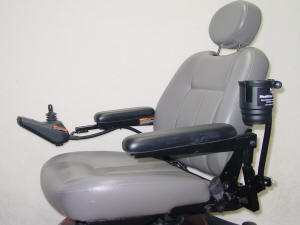
|
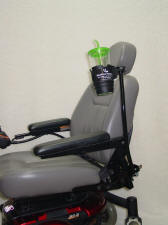
|
| Figure 2 - Cup Holder | Figure 3 - Hands Free |
Figure 3 shows the same configuration as shown in Figure 2 except the 12-inch flex arm has been replaced with an 18-inch flex arm. With the longer flex arm installed, the cup holder in now raised enough that the wheelchair user can drink directly from the cup by simply moving their head, i.e., without holding it. Thus hands-free drinking is readily available.
For most people who use their hands to lift a drink up to their lips, the most natural location for a cup holder is at the end of the armrest. In Figure 4 below, a 24-inch flex arm is installed using the same attachment location as shown in previous pictures. The flex arm is bent to approximately follow the curve of the armrest of the wheelchair and the cup holder is located at the end of the armrest. Once again, as in Figure 2, with this type of installation the armrest can be raised and lowered without disturbing the cup holder.
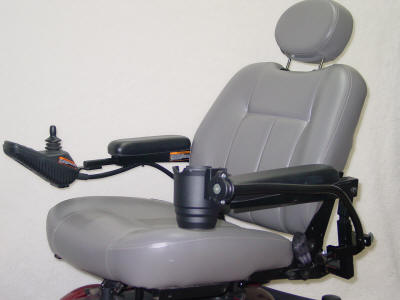
|
| Figure 4 - Front Mounted Drinking System Used as a Cup Holder |
This article shows one way of attaching a drink holder to a standard powered wheelchair. For more information or to purchase any of Mealtime Partners drinking systems, click here; otherwise you can always call 800-996-8607 for help in selecting the best drinking system for your application.
| Holiday Gift Ideas for Your Loved Ones | ||||||
| A hands-free
drinking system can enable someone to drink
independently throughout the day and is a gift that they
will appreciate all year. Mealtime Partners, Inc. has several different types of hands-free drinking systems to choose from: the Hydration Backpack with Drinking Tube Positioning; the Front Mounted Drinking System; and the Drink-Partner. They can all be attached to any wheelchair that has an exposed frame, handles, or slide-track rails to facilitate mounting, which allows them to be positioned to meet the individual user’s needs. |
||||||
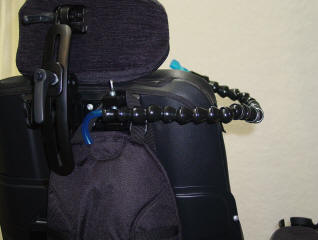
|
||||||
| Hydration Backpack with Drink Tube Positioning | ||||||
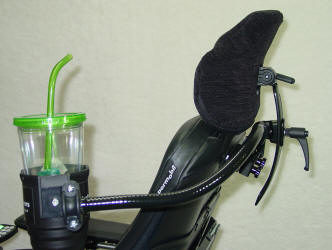 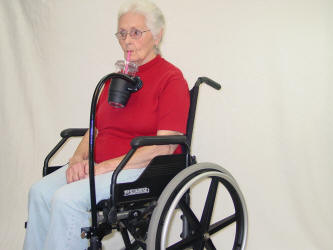 |
||||||
|
Front Mounted Drinking System for Wheelchairs with Slide-Track |
Front Mounted Drinking System for Manual Wheelchairs |
|||||
| To view all of the Mealtime Partners drinking products, click here. Remember, Mealtime Partners drinking products can be attached to powered wheelchairs with slide rails (standard and unitrack), manual wheelchairs with handles and/or tubular frames, on many standard wheelchairs, or on hospital beds with plastic or metal bed rails. For additional guidance about how to select the appropriate drinking system for your specific needs, click here. | ||||||
Mounting the Mealtime Partner Dining Device
Have you ever wondered why the Mealtime Partner Dining System has different mounting systems available? To answer this question a little history should be provided. Prior to the device being developed, Southwest Research Institute in San Antonio, Texas, conducted a study to identify what assistive dining equipment was available worldwide. The findings disclosed that there were four semi-automated feeding devices internationally available at the time the report was published in 1987. Because none of the devices sold well, an analysis was undertaken to find out why they were not more popular despite the number of people who are unable to feed themselves and who might benefit by using such a device. It was found that the majority of people (around 2/3) who might use the device, sit in a wheelchair to eat their meals. All of the devices available in 1987 had to be placed on a table to be used. The user had to scoot up to the table putting their knees under the table top, in the same fashion that most people do at mealtimes (as illustrated below).

|
The problem with this requirement is that if you sit in a wheelchair to eat your meals, the arms of the wheelchair will most likely prohibit you from moving close enough to the table to be able to reach either a plate or a dining device. It is especially unlikely for someone who sits in a powered wheelchair to be able to pull up to the table.
| Illustration of how the arms on a wheelchair can prohibit pulling the chair under a table. | |

|
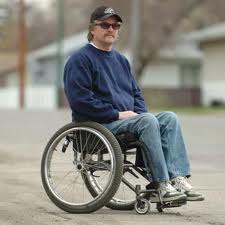
|
| Wheelchair with Arms will not fit under a Table | Wheelchair without Arms will fit under a Table |
Because being unable to access assistive technology for eating was identified as such a significant problem, when the Mealtime Partner Dining System was developed, access was one of the primary considerations in its design. Even in 2017, the Mealtime Partner is the only dining device that can be mounted in ways other than placing it on a table for use.
For those who are able to sit at a dining table to eat, the Mealtime Partner can either sit on the table for use or it can be mounted on legs that lift it to the appropriate height for the user. When the device is purchased with legs as its mounting method, it is supplied with a set of 2-inch high legs, a set of 4-inch legs, and a set of 6-inch legs. Mounting the device on legs is appropriate for anyone who is less than 6 feet tall. The 6-inch high legs are the tallest legs available and do not position the device high enough to facilitate a very tall individual reaching the spoon without leaning forward significantly, which is not a good position for eating or digestion. Therefore, for tall people other mounting methods are recommended.
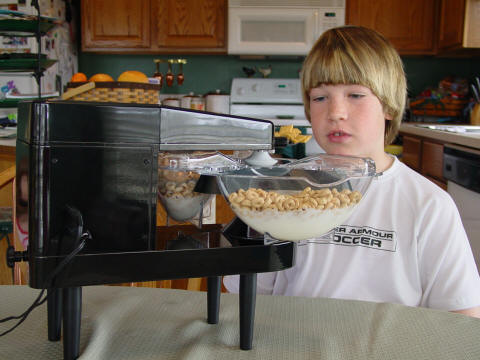
|
| The Mealtime Partner Mounted on 4-Inch Legs |
The Mealtime Partner can also be mounted on an adjustable Support Arm that is designed to allow the spoon on the Mealtime Partner to be positioned as precisely as a user needs. This is an essential feature for those individuals who have a very limited range of motion. Using the Support Arm, the spoon can be positioned such that the user needs to only move their head forward about 1 to 1.5 inches to remove food from the spoon. Because the Support Arm can extend beyond the table, it makes the Mealtime Partner accessible to those who sit in powered wheelchairs that, due to the size of the chair or because they have controls mounted in front, cannot be positioned very close to a table. Also, for those who require a laptray on their wheelchair, the Support Arm allows the Mealtime Partner to reach the user despite the laptray. The Support Arm is attached to a table (or other secure object) with the Mealtime Partner Table Clamp. The Support Arm allows the Mealtime Partner to be positioned for the user anywhere within an 18-inch area (vertically or horizontally), including below the table top.
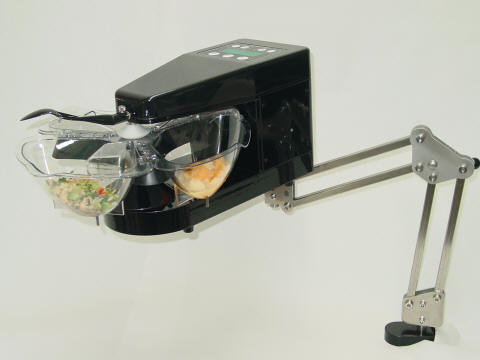
|
| The Mealtime Partner Mounted on the Support Arm |
A video is available to provide quick and easy instructions in setting-up and positioning the Mealtime Partner using the Support Arm. To view the video, go to the Training Page of the Mealtime Partners website and click on Training Video Segment: 3. Mounting. (The instructional video plays in around 4 minutes after the Player and video files have downloaded to your computer.)
For individuals who cannot eat from a dining device that is placed on a table, but who are able to move their trunk, the Mealtime Partner can be mounted on Mounting Shafts. Mounting Shafts are available in 5 different lengths: 2, 4, 6, 8 and 10-inches long. They are quicker and easier to set up and less expensive than the Support Arm, but are not continuously adjustable, being available only in discrete lengths. The Shafts, like the Support Arm, are attached to a table with the Mealtime Partner Table Clamp. Following the "safety first" policy employed in the overall design of the Mealtime Partner, the shafts will allow the Mealtime Partner to rotate away from the user if it were accidentally struck, but will not rotate so freely as to move when simply touched by the user.
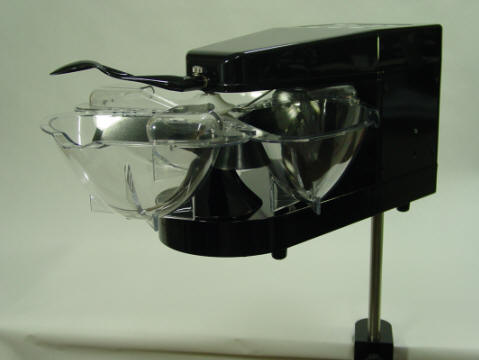
|
| The Mealtime Partner Mounted on a Mounting-Shaft |
It should be noted that when the Partner is mounted on either the Support Arm or a Mounting Shaft, the device can be rotated out from the table to which the clamp is attached. In the picture of the Mealtime Partner Mounted on a Mounting Shaft shown above, this feature can be seen. The edge of the table can be seen at the bottom of the picture and the body of the device is extended away from the edge of the table. The advantage of being able to move the device out from the table is that it facilitates access to the device for those users who are unable to move close to the table and put their knees under the table (like the wheelchair users described earlier). Because of these different mounting methods the Mealtime Partner is accessible to the majority of people who are unable to feed themselves. Systems can be purchased with a single mounting system or all of the mounting systems. A last note – for small children no mounting system is necessary. Simply put the Mealtime Partner on the table for use.
|
|
| The Mealtime Partner without a Mounting System |
- - - - - - - - - - - - - - - - - - - - - - - - - - - - - - - - - - - - - - - - - - - - - - - - - - - - - -
| Did You Know? Did you know that each year about 20% of the United States population catches the flu? Of course we are all encouraged to have a flu shot each year, but the shot does not necessarily stop you from catching the flu. The effectiveness of the flu shot varies from year to year ranging from under 20% to as much as 60%. Flu can be very serious, especially for the very young, the older generation, and those who are already sick and it can result in death. The Centers for Disease Control and Prevention estimates that 140,000 to 710,000 hospitalizations occur because of the flu, and anywhere from 12,000 to 56,000 deaths occur each year. 2017 is predicted to be a bad year for the flu and, therefore, it is even more important to get you flu shot this year! |
To subscribe to the Mealtime Partners Newsletters, click here.
Mealtime Partners Website Navigation:
Home | Dining | Drinking | All Products | Ordering | Training | Calendar | FAQ | Newsletters | Contact
Please send comments and suggestions to newsletters@mealtimepartners.com
Copyright © Mealtime Partners, Inc. 2017
All rights reserved.